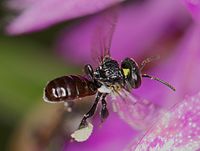
Photo from wikipedia
Central place foragers depart from and return to a central location with enough resources for themselves, and in many cases, for the group. Honey bees and bumble bees are eusocial… Click to show full abstract
Central place foragers depart from and return to a central location with enough resources for themselves, and in many cases, for the group. Honey bees and bumble bees are eusocial central place foragers. Honey bees use their unique dance language to recruit foragers to the most profitable patches. Bumble bees, on the other hand, exploit patches individually and develop trapline foraging patterns. Given the greater efficiency of the honey bee dance language for communicating the location of profitable resources to other foragers, based on optimal foraging theory, we predicted that bumble bees would put forth greater foraging effort than honey bees. We further hypothesized that both honey bees and bumble bees would respond to local resource availability, and that the foraging effort would reflect temporal fluctuations in colony needs. Using miniaturized radio frequency identification (RFID), we tracked the foraging patterns of individual bees to and from hives at three sites and over five time periods during the 2016 flowering season in south-central Wisconsin. Pollen pellets were also collected from bees returning to the hive. We compared the European honey bee, Apis mellifera, and the common eastern bumble bee, Bombus impatiens. Linear mixed effect models determined the impact of bee species, time of season (period) and site, and their interactions, on multiple foraging effort metrics and on pollen dry weight. Relative to honey bees, individual bumble bees made more foraging trips each day, resulting in a greater time spent foraging. A greater proportion of RFID tagged bumble bees foraged each day and bumble bees brought heavier pollen sacs to the hive compared to honey bees. Foraging bout duration did not vary between bee species and none of the foraging effort metrics varied among time periods or among sites. Both bee species, however, brought heavier pollen sacs back to the hive at the beginning and the end of the flowering season. These results are discussed in terms of the different foraging strategies of the two bee species, temporal and spatial variation in resource availability, and with reference to future research using miniaturized animal tracking technologies in the context of optimal foraging theory.
Journal Title: Frontiers in Ecology and Evolution
Year Published: 2018
Link to full text (if available)
Share on Social Media: Sign Up to like & get
recommendations!